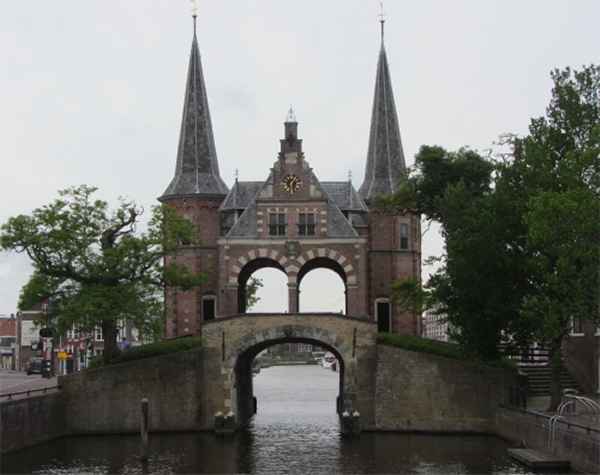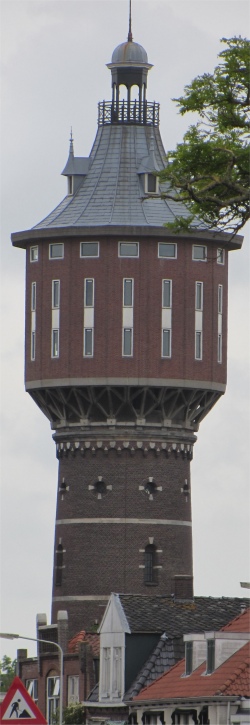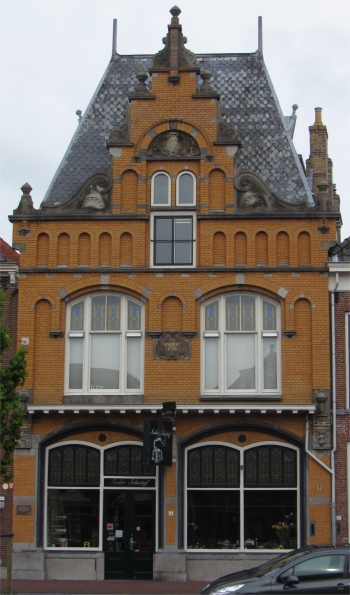 Convoy Down the Broad Prinses Margarietkanaal |
I prepared a huge fruit cocktail for breakfast. Meryl fancied fruit rather than bacon and eggs. There was a strong form of central governance on this ship. Rex secretly cursed, "Nelson didn't have this trouble." Such is life.
Shortly after 9am, the magical bridge opening time, we left on our journey to Sneek. We had barely covered a mile when we noticed people shouting and waving to us from the bank, forming a cross their arms and then pointing to the next bridge. We gathered that the bridge was broken.
I spoke with the people on the large barge behind us, a Dutch crowd. "Will the bridge be repaired today?" I asked. "Waarschijnlijk (probably)," was the response. "Any idea when?" was my next logical question. A shrug of the shoulders was the response.
 Barge on the Sneekermeer |
 I'll Do You a Swap |
Within a few kilometres we had settled into a convoy of four boats: German, Belgian, Swedish and British. As usual, the German was leading the pack. After travelling down south through lush pastoral land, we came across the town of Grou. This posed a bit of a teaser. In front of us was a bridge with a red light on it. Now according to the charts, this bridge didn't open, and the only route available to us was a sharp turn left, and then after 300m, a sharp turn right. To compound confusion, we were at a cross roads in the canal system. It had no traffic signals, no directional signs, and approach routes were masked by trees rendering it necessary to have a crew member on the bow to peer around the corner. Who gave way to whom? We and the Belgian did the two step shimmy as per charts. The German and Swede milled about in circles. We left them behind, and then to our amazement, we saw the bridge opening. Too late, we were already committed to our alternative. In five minutes the two boats which had passed through the bridge joined us, the Swede having edged his way in front of us in the diversion.
 Stadhuis |
The canal eventually opened out into the Sneekermeer, a large lake. Indeed, this whole area of Southern Friesland is known as the Frisian Lake District, due to the numerous lakes contained within it, all connected by a network of canals.
I watched a large barge of the "brown fleet", full of teenagers, ply back and forth across the lake, with a fair speed in the breeze despite its size. With the wind billowing in her sails, she was a lovely sight to behold.
The bottom end of the lake narrowed, and as yet another leviathan steamed up channel towards us, we veered off to starboard and followed a channel up into Sneek, the second largest town in Friesland. We tried to tie up on the municipal moorings along Sommerak on Het Eiland, but they were all occupied. We turned around and headed up Jachthavenkanaal which lead to three marinas, and we chose a delightful little marina, B.V. Sneeker Jachthaven, in the town. On one side, we were surrounded by residential buildings, fronted by a strip of grass along which mallards and coots marched on parade. The other side was taken up by long, low, black wooden buildings, built out over the water. These were all boat houses, all full as far as we could ascertain by peering through windows.
 Waterpoort |
In a house across the marina from us, a drummer was raising a hell of a din in his bedroom. Otherwise, the tranquil setting was only disturbed by waddling ducks preening themselves, the dull padding of joggers, or brief exchanges of pleasantries between dog-owners as they walked their pets alongside the marina. The sun shone brightly and it really was a gorgeous setting. To make the day even brighter, I received a call from my eldest daughter wishing me happy Father's Day, and later I received a similar text message from Dan. I'd forgotten all about it, but I was chuffed that they had remembered and had bothered to contact me.
Sneek received several city rights in the 13th century, which became official in 1456. Sneek was now one of the eleven Frisian cities. This was also the beginning of a booming trading city that would last until the year 1550. In 1492 they began building a ditch and wall around the city. In those days Sneek was the only city in Friesland that had a wall. Only the Waterpoort and the Bolwerk are remaining today. The city was an important shipbuilding centre as early as the 15th century, a prosperous maritime city protected by an extensive system of walls and moats. This was reflected in today's traditional setting, the old city being surrounded by a diamond of canals. Post-war development has robbed the place of some of its charm but there are still some buildings of interest, notably the grandiose Waterpoort at the end of Koemarkt, all that remains of the seventeenth-century town walls.
 Watertoren |
In the evening, we took a stroll into town, passing a sports field which had deer grazing in it. The town was crammed with upmarket shops, all closed at this late time of the day, and a collection of beautiful old buildings dating back to the 17th and 18th centuries. Many children with painted faces were being led by their parents, probably the remnants from a fete earlier in the day.
In Marktstraat the former Stadhuis proudly stood, a notable 15th century building, with a magnificent Rococo facade (1760) - a rare feature in Friesland.
 Typical Sneek Building |
The continuation of Kerkstraat, the Oude Koemarkt, runs south to the gracht called the Geeuw. Off to the right is the Waterpoort (Water Gate) of 1613, the only remnant of the town's fortifications, which were demolished in the 18th century. This picturesque old gate bridging a canal consisted of two octagonal towers joined by a kind of loggia. We stood a while on the arch of the Waterpoort, watching large gin palaces entering De Kolk at the head of the Geeuw as far as the Waterpoort, and then turn abruptly right through the raised bridge into the Stadsgracht. A small yacht was tied up near the Waterpoort, with adults and children in the cockpit enjoying a spread a food. Rex reckoned there must have been sixteen folk on board. Hmmm... sardine boat.
In the distance beyond the Waterpoort, the Watertoren could be seen dominating the skyline. The Watertoren was built in 1908 in the Neo-Renaissance style. The 44m high tower, which had a national monument status, contained a 350 cubic metre reservoir. Since 1998 the tower has been used as an office.
We found the restaurant the harbour master recommended, De Walrus. Outside, it didn't seem particularly busy, but inside it was heaving with people, obviously very popular. There was a queue of people waiting for tables, but somehow we bypassed it as a waitress grabbed us and plonked us down at a very tall table with equally tall seats, near the window. Did she take pity on us for some reason?
The food and drink was excellent, as was the company. Around us, several families sat with small children, all well behaved. Meryl also noted that Dutch people tend to eat out a lot earlier in the evenings compared to Britain.
Sadly, Rex plied me with whiskey when we got back to the boat. I haven't quite figured out why Rex and Meryl try to overdose me with alcohol. As we sat outside on the boat, the skies glowed gloriously, promising a fine tomorrow. Fish lazily surfaced and guzzled a careless fly, while ducks promenaded in their Sunday best along the grassy banks. Perfect ending to a lovely day.
